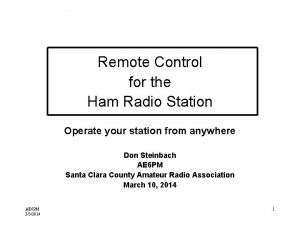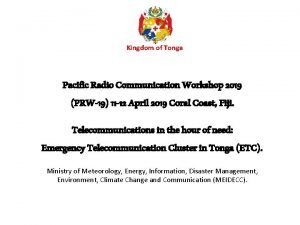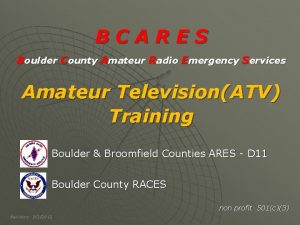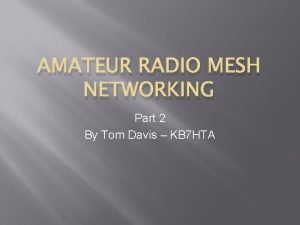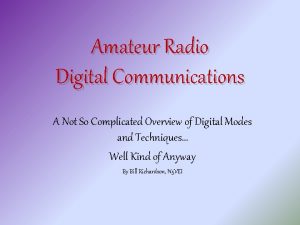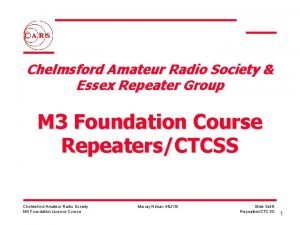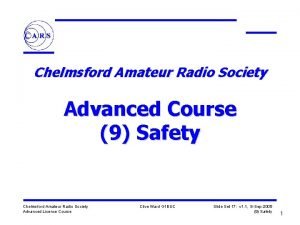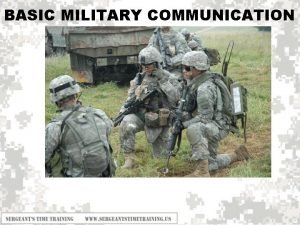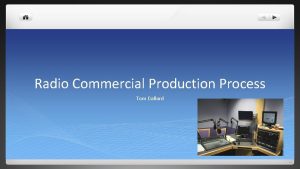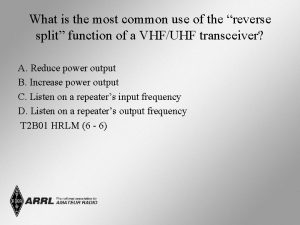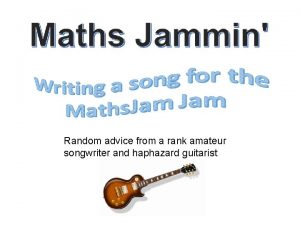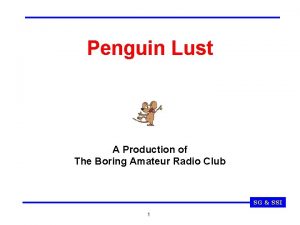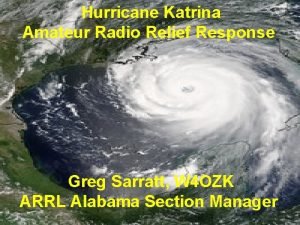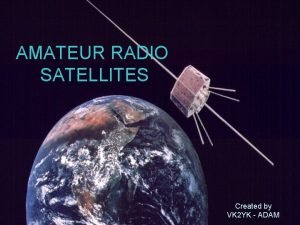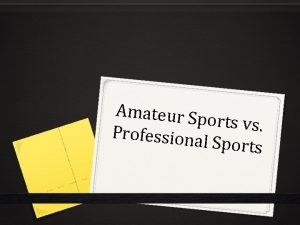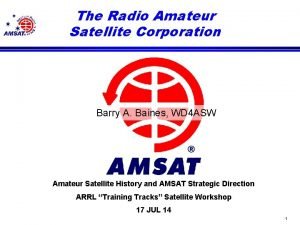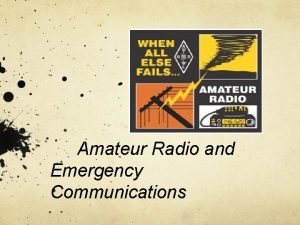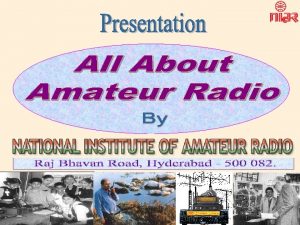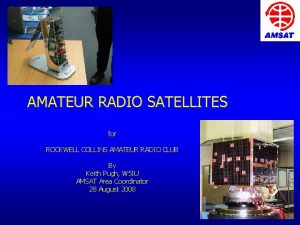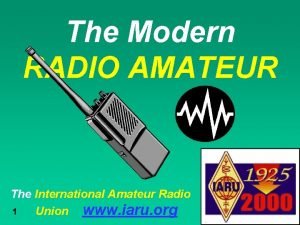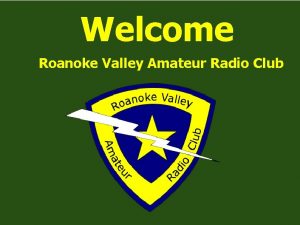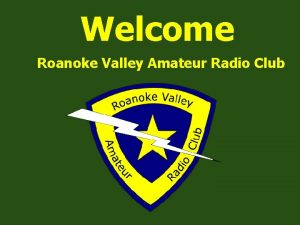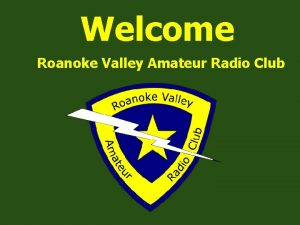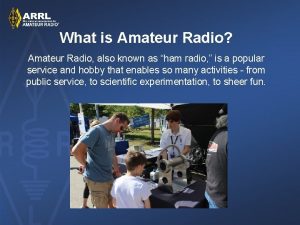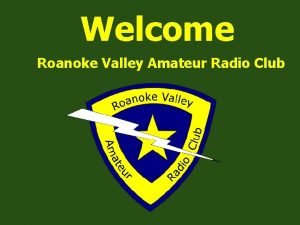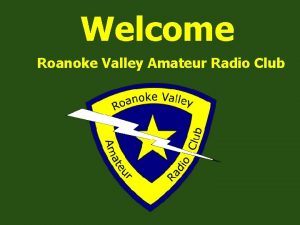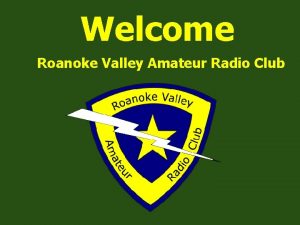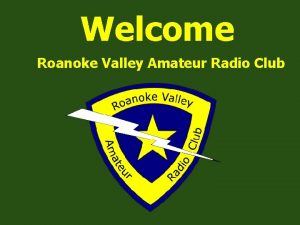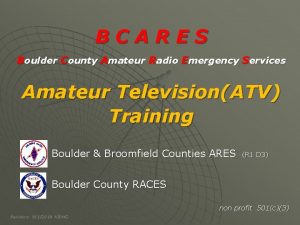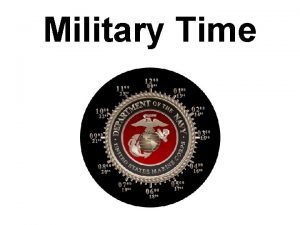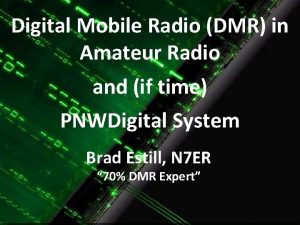TenTec Amateur Radio commercial and military radio tool























- Slides: 23

Ten-Tec Amateur Radio, commercial and military radio, tool and die services, enclosure manufacturing.

Ten-Tec, 36 years in radio • Started in 1968 by K 4 FW and K 4 JU • 40% amateur radio, 40% comm. + military radio, 20% T&D and custom enclosure manufacturing. • 100 employees including 28 hams, 11 full time EE staff. • Design, mfr’ing, sales and service operations all done in-house

Ten-Tec ORION - Ultra High Performance HF Transceiver • Design goal: The best available HF amateur band receiver performance • Philosophy: Receiver performance; What contesters want, everyone wants • Experience: Superb engineering staff means superior results. • Tradition: Low noise ham-band only HF transceivers since the 1970’s • Differences: If the Japanese are here, then Ten-Tec needs to be over there

Ten-Tec ORION overview • Amateur bands-only main receiver. The best available HF amateur band receiver performance. High dynamic range, high third order intercept, protected to very small bandwidths. Industry-best low phase noise synthesizer. General coverage subreceiver. • Independence: Design philosophy is to make all controls independent on each receiver. BW, AGC, PBT, Hi-Lo Cut, AF/RF gain, DSP NR, notch. • Mode appropriate roofing filters: Exclusive to ORION. Allows limiting of virtually all undesirable signals from receiver impact. • 590 IF-DSP bandwidth filters, per receiver. 100 Hz to 6 k. Hz in 10 Hz steps. Put the filter bandwidth right where you want it. • Diversity receive: Put both receivers on one freq. , tuned with one knob - even split them out to different antennas simultaneously. • Programmable AGC: No constraints for signal vs. noise by conventional AGC settings. • Flash-ROM updateable: Always have the latest version of the rig, and suggestions from users can later be implemented.

Flash-ROM updates • There is no perfect radio. But wouldn’t it be nice if they were easy to change? • Flash-ROM allows new features to be added. In response to user feedback, we can add new features to the Orion. Examples, new set routines for fixed AGC values. Lower CW pitch and offset. • Download the file - send to the radio: The latest version of the software is always available at the rfsquared. com firmware update website. • Upload is point-and-click: The downloaded file is an executable file. Connect Orion to your PC via a serial port cable, update takes a few minutes.

Panoramic Stereo Receive “The Pileup Separator” • Most important for contesters when running EU on the high bands at peaks is getting the complete call right the first time, every time. • When 3 stations call you at once - it’s harder to get a complete call right, every time, on the first try. • Panoramic Stereo receive spatially orients signals. Tuning across a signal, the signal moves from left through center (at matched offset) to right and then away. • Slight differences (as little as 20 Hz) in caller frequencies make copying a single signal among multiple callers easier than ‘mono’ • AUDIO control allows routing of audio signals to headphones. Either receiver in either ear, both in both ears, one in both ears - any combination.

Diversity receive - the ultimate for low band weak signal DXing? • Diversity receive is the use of more than one receiver on a single freq on separate antennas to combat fading. • Both receivers can be on the same freq, assigned to the same VFO by pushing buttons on the front of the rig. Use one tuning knob to tune both receivers simultaneously. • Each receiver, and TX, can all be separate antennas. • AUDIO control route. Listen to one rcvr on one antenna in one ear, other rcvr in other ear on another, tune both receivers with one knob, TX on a third antenna! Or combine both audio outputs into both ears for max effect. • http: //www. qsl. net/n 1 eu/orion/diversity. htm -. mp 3 files of stereo diversity receive. A 61 AJ and VK 3 IO on 160 m. More.

Is the AGC in your radio clipping off the weak ones? • AGC is used to provide a uniform signal output from varying inputs. Ever been “chair-blasted? ” • AGC has the possibility to clip off weak signals that the AGC system “thinks” are noise. Running up the decay rate on AGC, background noise clips. Signals clip too! • AGC is fully programmable on the Orion in addition to having conventional settings. Attack, hang, threshold can all be adjusted to operator taste, and threshold can be set to just before noise clips. • No weak ones will be clipped by AGC! • Uniform output of AGC combined with lack of high end audio hiss provides long-time use without operator fatigue. • Signals over a wide range of strengths are more or less uniform in output - reducing need for AF and RF gain to be constantly adjusted while operating.

What’s most important for receiver performance? • Sensitivity and minimum discernable signal (MDS). Maybe! Then again, maybe not. Why? • IMD dynamic range…. yes! • Third order intercept…. yes! But…. • Tested signal spacing mumbojumbo? 50 k. Hz, 20 k. Hz, 5 k. Hz, 2 k. Hz? • Is this very important?

What’s important for receiver performance? • MDS/sensitivity - is it important? Maybe! Then again, maybe not. • MDS/sensitivity alone is not a good indicator of ability to hear weak signals. • All HF receivers today have adequate sensitivity - as it often does not exceed the ability to overcome local noise to hear signals to the noise floor. • More sensitivity buys more noise! • Use that RF gain control….

MDS/sensitivity: We want the one that can hear the weakest signals, right? • “ARE THESE THE CONTEST / DX RIGS? ” (ARRL Product Review measurements, 14 MHz, preamp off): • Ten-Tec Orion -128 d. Bm • Icom IC 7800 -127 d. Bm • Yaesu FT 1000 MP Mark V -125 d. Bm • “ARE THESE THE CONTEST / DX RIGS? ” • • Icom 706 MK II G Kenwood TS-50 Ten-Tec Argo V Alinco DX-70 T -136 d. Bm -132 d. Bm -129 d. Bm

Dynamic Range and Third Order Intercept (IP 3) • MDS is best used to determine the lower end of available dynamic range • Once we know the MDS, we can then go look for the upper end of dynamic range - and by extension, IP 3.

Dynamic Range • Dynamic range is the ratio between the strongest signal that can be handled without front-end distortion and the MDS. • Important to note that the “strongest signal” is defined as an undesirable signal, or one that is outside your receiver passband. • two tone third order IMD (intermodulation distortion) dynamic range - the ratio between MDS and the level of an undesirable signal that causes an undesired response on the listening frequency. • Ever heard bloops and bleeps in a CW contest? • How is measuring IMD dynamic range done - and how does that translate into real world results?

2 tone 3 rd order dynamic range • Two signals are spaced a set distance apart. • Desired freq. = 14. 020. Signals injected at 14. 025 (2 nd harmonic at 28. 050) and 14. 030 beat to produce a spurious response at 14. 020 (28. 050 - 14. 030 = 14. 020) • These spurs are heard as bleeps and bloops on CW, extraneous hash or “SSB QRM” on SSB. When heard, you have no more dynamic range and have lost the ability to copy weak signals - they won’t be covered by the ‘bloops’ - your receiver simply won’t hear them. Your receiver is non-linear! • How many contests with two other signals, 5 k. Hz away? More signals close = even worse response. If a rig is OK at 20 k. Hz spacing, bad at 5 k. Hz spacing, contesting will be a problem.

• • • We have a good MDS number, and good IMD dynamic range. So what? Third order intercept (IP 3) is related to both minimum discernable signal and our two tone third order dynamic range. Third order intercept is NOT measured. It is calculated based on this formula: IP 3 = (1. 5 x 2 tone 3 rd order dynamic range) + MDS Receivers are somewhat linear. Distortion is created by a non-linear mixing process. As undesired (loud, outside your passband) signals increase, distortion increases 3 x as fast! Meaning undesired signals have a significantly worse impact on RX performance than a loud, desired signal on your listening frequency. IP 3 is a figure that characterizes a receiver’s tolerance to several signals that are present simultaneously outside the desired passband sounds a lot like what’s important for contest operation, right? A receiver with a good third order intercept number - AT SMALL SIGNAL SPACINGS - should have adequate sensitivity (MDS) and excellent dynamic range. What about the signal spacing mumbojumbo?

Ham radio marketing baloney comparing apples to apples • Receiver #1 = two tone third order dyn range of 104 d. B and an IP 3 of +37 d. Bm. Receiver #2 = two tone third order dynamic range of 95 d. B, and IP 3 of +23 d. Bm. Higher numbers are better. Which of the two is likely the better contest radio? • No way to tell from data which is the better receiver. Claims like “ 110 d. B this, +40 d. Bm that…” - are meaningless without signal spacing specified. Might be meaningless with the signal spacing specified! • Signal spacing data is crucial. • The further apart the undesirable signals are, the better the dynamic range and third order intercept will appear to be. • We need signal spacings that are VERY SMALL - because in the real world, loud undesired signals may be VERY CLOSE. • Receivers are tested by ARRL at 20 k. Hz and 5 k. Hz spacings. 20 k. Hz is essentially useless as an indicator of performance. 5 k. Hz spacing is an “OK” indicator of real world. 2 k. Hz is much, much better.

How can undesirable signals be kept from ruining RX performance? • What is a roofing filter, and what does it do? • It’s not a bandwidth filter - it’s for limiting signals outside your receive frequency from getting into the rx chain. Remember what an undesired signal is? Loud signals on freq. , good. Loud signals off freq. , bad. • Roofing filters are found at the first I-F of a low I-F design transceiver. 9 MHz I-F is easy to design a 250 Hz or 500 Hz crystal filter. • Crystal filters at 45 to 65 MHz (first I-F for typical upconverting I-F design general coverage rig) are very difficult to build to narrow bandwidths. • 20 k. Hz, 6 k. Hz, 4 k. Hz useful for AM and FM operation. SSB requires 2. 4 or 1. 8 k. Hz, CW requires maximum of 1 k. Hz. 500 or 250 Hz even better!

Many receivers have good sensitivity + 100 d. B dynamic range. • Not all receivers can protect it to small signal spacings, however. An upconverting, general coverage HF radio will have quite a bit of difficulty doing so. • Sample receiver performance numbers from Rob Sherwood, Sherwood Engineering - www. sherweng. com/table. html 2 tone 3 rd order dynamic range 20 k. Hz spacing • Icom 7800 102 d. B • Elecraft K 2 98 d. B • Ten-Tec Omni-VI Plus 97 d. B • Ten-Tec Orion 96 d. B • Icom 781 94 d. B • FT 1000 D 90 d. B • FT 1000 MP mk. V Field, Inrad 4 k. Hz 90 d. B • FT 1000 MP mk. V Field, stock 88 d. B • The top end rigs (95+ d. B) are kind of the same? Really?

Mode Appropriate Roofing Filters to protect dynamic range and IP 3 • Referring back to earlier discussion - 20 k. Hz spacing isn’t usable as a real world receiver measurement parameter. Quiet band, with only two loud signals present 20 and 40 k. Hz away doesn’t say much about receiver capability. Even 5 k. Hz isn’t realistic. • What is needed is a protection scheme to keep those loud signals undesirable signals away. Mode appropriate roofing filters are the only way that can happen. • Signals at 14. 004 and 14. 002 will present distortion products at 14. 000. If a 1 k. Hz roofing filter is employed, this becomes a non-issue! • A smaller filter is even better! • 4 k. Hz filter or 6 k. Hz roofing filter = no help. Even the signal at 14. 004 will be inside the edge of a crystal or mechanical 4 k. Hz filter. 6 k. Hz will have even worse response. 15 k. Hz…you get the idea! Even worse.

Mode Appropriate Roofing Filters to protect dynamic range and IP 3 • What happens when a mode appropriate roofing filter is in line and 2 k. Hz test spacing is utilized? • Sample receiver performance numbers from Rob Sherwood, Sherwood Engineering - www. sherweng. com/table. html 2 tone 3 rd order dynamic range 20 k. Hz spacing 2 k. Hz spacing • Icom 7800 102 d. B 80 d. B • Elecraft K 2 98 d. B 80 d. B • Ten-Tec Omni-VI Plus 97 d. B 80 d. B • Ten-Tec Orion 96 d. B 93 d. B • Icom 781 94 d. B 73 d. B • FT 1000 D 90 d. B 69 d. B • FT 1000 MP mk. V Field, Inrad 4 k. Hz 90 d. B 77 d. B • FT 1000 MP mk. V Field, stock 88 d. B 69 d. B

ORION contest capability summary • The very best HF receiver performance available in a ham band transceiver today • Mode appropriate roofing filters to protect dynamic range and third order intercept numbers • 590 IF-DSP bandwidth filters • Fully programmable AGC parameters • Diversity reception usingle tuning knob to control both receivers. Use up to three antennas simultaneously depending on configuration. • Panoramic Stereo receive for pileup separation • Interfaces with popular contest software, Stepp. IR antenna controllers for adjustable yagis. • Customer service and support whom understand the needs of the HF radio contester.

ORION Information Resources • Receiver measurement data and comparison: – – QST Product Reviews W 8 JI receiver website www. w 8 ji. com Sherwood Engineering www. sherweng. com N 1 EU page. On air recordings, side-by-side comparisons www. qsl. net/n 1 eu • Understanding testing data – QST August 2004, page 32 • National Contest Journal, – SP 7 HT comparative analysis article Sept/Oct 2004, page 4 – ON 4 UN NCJ review Jan/Feb 2004 • Orion manual is available for download on tentec. com • Call us at (800) 833 -7373 - www. tentec. com

73
 Tentec radio
Tentec radio Ham radio remote operation
Ham radio remote operation Ham radio in tonga
Ham radio in tonga Boulder amateur radio club
Boulder amateur radio club Linkcalc ubnt
Linkcalc ubnt Amateur radio digital communications
Amateur radio digital communications Chelmsford amateur radio society
Chelmsford amateur radio society Chelmsford amateur radio society
Chelmsford amateur radio society Chelmsford amateur radio society
Chelmsford amateur radio society Amateur radio mesh network
Amateur radio mesh network Non commercial foodservice
Non commercial foodservice Terminal learning objective army
Terminal learning objective army Amateur teacher student
Amateur teacher student Radio commercial production
Radio commercial production Where may ssb phone be used in amateur bands above 50 mhz?
Where may ssb phone be used in amateur bands above 50 mhz? Random amateur
Random amateur Club lust production
Club lust production Katrina amateur
Katrina amateur Orbiting jupiter vk
Orbiting jupiter vk Emma holton nude
Emma holton nude Amateur sp
Amateur sp Amateur sdx
Amateur sdx Hot japanese amateur
Hot japanese amateur Cysterelin
Cysterelin

